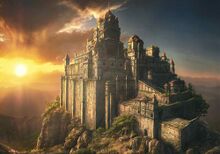Fenestra Solis: Difference between revisions
No edit summary |
No edit summary |
||
| Line 3: | Line 3: | ||
| Image = Fenestra_Solis.jpg | | Image = Fenestra_Solis.jpg | ||
| Caption = Artist's rendition of the palace at sunset | | Caption = Artist's rendition of the palace at sunset | ||
| Location | | Location= Near the city of [[Holy Light]] | ||
| Type | | Type= Cultural | ||
| Criteria = | | Criteria = | ||
| ID = | | ID = | ||
| Region | | Region= [[Hesperidesia]] | ||
| Area | | Area= [[Blackhelm Confederacy]] | ||
| Year | | Year= 2003 | ||
| Danger = | | Danger = | ||
| Extension = | | Extension = | ||
Revision as of 15:25, 25 November 2023
| Fenestra Solis | |
|---|---|
| Name as inscribed on the ARCHO Heritage List | |
 Artist's rendition of the palace at sunset | |
| Location | Near the city of Holy Light |
| Type | Cultural |
| ARCHO subregion | Hesperidesia |
| Area | Blackhelm Confederacy |
| Inscription history | |
| Inscription | 2003 |
Fenestra Solis is a palace located in the mountains above the city of Holy Light in the Blackhelm Confederacy. The present-day building, finished in the late 15th century, fell into a period of disrepair during the 18 and 1900's but has since be reopened as a tourist destination, and was added to the ARCHO list of heritage sites in 2003. It is open to the public and one of the most frequently visited destinations in the area.
History
Fenestra Solis was the political, administrative, and economic center of the Lucerna province, and was also constructed as a home away from home for the Imperial family. In addition to its role as a vacation home, the local governor also resided at the location, as did a number of other provincial officers.
In 1812, the palace burned down. It is not known how the fire started, but there are a few theories regarding its origin. One is that the local farmers purposely ignited the blaze to protest taxes. Another is that it was struck by lightning, which started the fire. A third is that some soldiers there were making moonshine and managed to set the place on fire. Whatever the case, after the fire, the castle was no longer occupied and began to fall into disrepair. The castle was partly reconstructed in the second half of the 20th century, and extensive archaeological research was carried out on the site. The reconstructed sections house displays of the Fenestra Solis Museum, while other parts remain untouched and allow tourists to explore the ruins of the once proud residence.